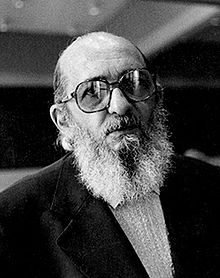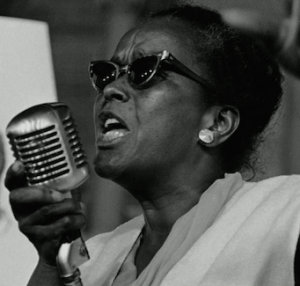The two words in the phrase community organizing are often taken for granted, but their meaning implies the presence of a few things. First, a community must exist. This means that there is a collection of people that share some aspect, value, or interest in common. Once this community is formed, they can organize, but to organize requires a subject to organize around. This requires consensus among the group about what issues are important to them, and where their shared interests lie.
Several writers and activists point to the ways in which a group can develop a recognition of itself and discover what they have in common that they want to organize around. The three individuals whose ideas I highlight in this section are Paulo Freire, a groundbreaking liberatory educator from Brazil, Saul Alinsky, a well-known radical organizer, and Ella Baker, an unsung hero of the Civil Rights Movement.

Paulo Freire. Source: https://en.wikipedia.org/wiki/Paulo_Freire
Paolo Freire believes in bringing people together in order for them to find common ground and view themselves as a collective with common issues to work towards. The important part for Freire is that issues to organize around are generated from within the collective. Freire sums up his perspective on organizing when he says “Do the people have the right or not to participate in the process of producing the new knowledge? I am sure that a serious process of social transformation of society has to do that” (Horton, Freire, Bell, Gaventa, & Peters, 1990, p. 97). He sees social change as necessarily participatory, and he believes that the collective production of knowledge by the people will be what leads to serious, lasting social change.

Saul Alinksy. Source: https://www.counter-currents.com/2016/09/alinskys-farting-negroes/
Like Freire, Saul Alinsky believes that the step of action cannot happen without a community first experiencing a feeling that they have common issues among them that they can work together to solve. Unlike Freire, however, Alinsky (1971) thinks that the way to develop this community was through agitation by the organizer around certain issues; he believes that “the organizer’s first job is to create the issues or problems” (p. 119). He then follows this up by saying that “what the organizer does is convert the plight into a problem” (p. 119), meaning that while people are experiencing difficult circumstances, they need the organizer’s help to recognize these plights as problems that they can organize to solve together. This means that the organizer has some power to determine which problems should be focused on.

Ella Baker. Source: https://zinnedproject.org/materials/baker-ella/
Ella Baker believes in empowering people who recognize themselves as a group by giving people information and allowing them to do what they see fit with that. In her words, “people, when informed about the things they are concerned with, will find a way to react” (Mueller, 2004, p. 84). She believes that the best way to bring people to a common consciousness through which they can make collective decisions about certain issues is to provide them with information and allow them to react. The organizer has a hand in this process, but only as the provider of information.
No matter which tactic is chosen, organizing requires people to come together around issues. Organizing is not a project that can be carried out by an individual; it is inherently collective. There are many different ways to go about organizing into a group that identifies with each other and cares about issues, but this is necessary for organizing to be effective.
